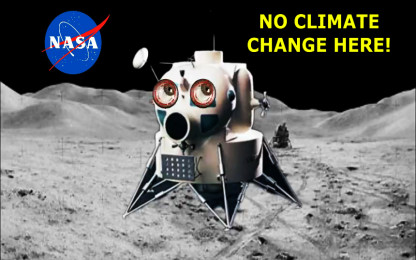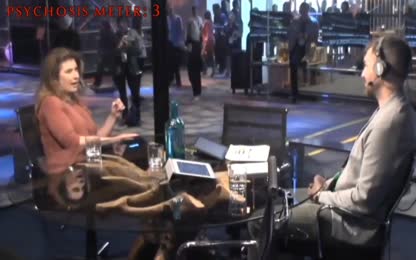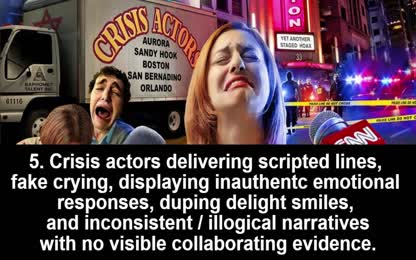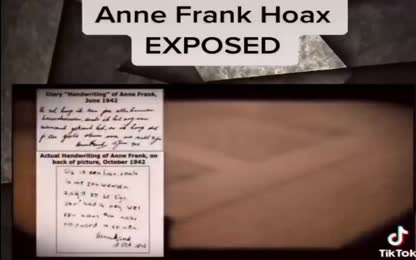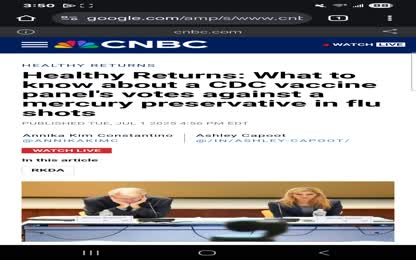Advertisement
Buzz Aldrin Agrees With NASA Apollo Mission Was a Hoax
Buzz Aldrin was an exhibitor at the 2015 National Book Festival to promote his new book with National Geographic: Welcome to Mars: Making a Home on the Red Planet.
Zoey chats with Apollo 11 astronaut Buzz Aldrin. https://theroarbots.com/tag/national-book-festival/
Better Mankind Youtube video mix: https://youtu.be/DpPMoIv1lxI
More Than 175 Authors to Participate in Library of Congress National Book Festival: http://bit.ly/2Aq6WBR
- Category: NASA / ISS /Mars/ Moon Landing
- Duration: 10:48
- Date: 2018-07-31 02:00:44
- Tags: buzz aldrin, apollo, moon landing
8 Comments
Video Transcript:
Why has nobody been to the morning such a long time? That's not an eight-year-old's question. That's my question. I want to know, but I think I know. Because we didn't go there and that's where it happened. Hi everyone and welcome to yet another controversial Better Man kind video. I think subconsciously there must be a part of me that enjoys the onslaught of nasty comments when I make videos like this. But the fact remains that there's way more evidence that supports the theory that we never went to the moon than there is to support that we ever did. There are many reasons that prove we never went to the moon. To mention a few, you have the wavy flag in a zero atmosphere environment. The lack of any blast crater underneath the lunar module. For how about the absence of stars in space? The problem with any of these arguments is that NASA seems to have an explanation for every single one of them. Therefore, people like me and other moon landing deniers are referred to as a bunch of crazy tinfoil, hat-wearing conspiracy cooks that need to up their medication. So in this video, I'm only going to address a single discrepancy of the NASA themselves have admitted to on more than one occasion and will prove without a doubt that we have never even left low Earth orbit, let alone landed a man on the moon. But first let's go back to school and get a refresher course on the different atmosphere surrounding the Earth. Now the following information is critical to proving my point so please bear with me. First we have the troposphere. This is where all of our weather occurs and it is the lowest layer of the Earth's atmosphere. It starts at the Earth's surface and extends up to a height of 4 to 10 miles. Next we have the stratosphere which extends to about 35 miles above the Earth's surface. This is where our ozone layer resides and protects us from those dangerous UV rays. It is also the layer where aircraft travels as it is free from weather disturbances. Now we go up to the mesosphere where most meteors burn up on entry. The mesosphere stretches up to 50 miles above the Earth's surface. Next we have the thermosphere and this layer extends up to 400 miles from the Earth's surface and the air here is very thin. Also temperatures here start to get really hot ranging anywhere from 200 to 500 degrees Celsius and 500 to 2,000 degrees Celsius in the upper region. And last but not least is the exosphere. The temperature in the exosphere can vary from 0 to 1700 degrees Celsius. The exosphere is the outermost layer of the Earth's atmosphere and is around 6,200 miles from the Earth's surface. Now according to NASA, low Earth orbit is around 1200 miles from the Earth's surface. So before I tell you the reasons why it is impossible for us to go beyond the exosphere or for that matter even past the thermosphere, have a listen to what some NASA experts have to say about this topic. As we get further away from Earth, we'll pass through the Van Allen belts, an area of dangerous radiation. Radiation like this could harm the guidance systems, onboard computers or other electronics on Orion. But Orion has protection. Shielding will be put to the test as the vehicle cuts through the waves of radiation. Sensors aboard will record radiation levels for scientists to study. We must solve these challenges before we send people through this region of space. Hang on, hang on. So what you're saying is that in order to send humans through this region, we need to solve the challenge of getting through the Van Allen radiation belts. But I'm confused. Didn't you already solve this challenge back in 1969 when you sent astronauts to the Moon? And subsequently five other times after that? Sorry, but we're also really pushing the boundaries in terms of where we're going forward with exploration. I think humans are naturally driven to do this. And this is really the beginning, I think, of human beings leaving low Earth orbit. I certainly plan on being around to see that. So she's a NASA astronaut, but I guess no one bothered to tell her about the first time that we left low Earth orbit. I guess she might be a little too young to remember. Here we have another astronaut that wasn't told about the Moon landing 48 years ago. The plan that NASA has is to build a rocket called SLS, which is a heavy-lift rocket. It's something that is much bigger than what we have today. And it will be able to launch the Orion capsule with humans onboard, as well as landers or other components to destinations beyond Earth orbit. Right now, we only can fly an Earth orbit. That's the farthest that we can go. We only can fly an Earth orbit. That's the farthest that we can go. And this new system that we're building is going to allow us to go beyond and hopefully take humans into the solar system to explore. So the Moon, Mars, asteroids, there's a lot of destinations that we could go to and we're building these building block components and order to allow us to do that, actually. Once we travel beyond the Earth orbit, the crew will be exposed to larger amounts of radiation. So we have to design both the crew protection systems and our electronic systems to withstand this radiation. So that would mean that Neil Armstrong, Michael Collins and Buzz Aldrin were a tough bunch of SOBs able to withstand all that brutal radiation considering these challenges are still yet to be solved. So how is it that we had the technology to achieve this amazing feedback in 1969, but we're still working on the technology in 2017 almost half a century later. Well, I managed to find a very clever and well-informed astronaut that will totally strait things out for us and explain exactly why we're not able to return to the Moon and break through those Van Allen radiation belts. Have a listen to this Clevver chat. I'd go to the Moon in an hour and a half. The problem is we don't have the technology to do that anymore. We used to, but we destroyed that technology and it's a painful process to build it back again. This guy, oh boy. Here's a real life example of what can happen to you when you're exposed to all of that outer space radiation. And if you're a child with aspirations of becoming a astronaut, being a very good liar might be a positive attribute to have on your resume. And just by showing you these admissions of guilt by NASA, I can easily end this video now and I would have easily proven my point without a shadow of a doubt. But I'm sure that for some of you hard and skeptics out there, this damaging evidence is still not enough. So let's take this theory of mind to the next level. This here is the Lunar Module now proudly displayed at the National Air and Space Museum. According to NASA, the primary materials used to build the module were aluminium alloy, stainless steel, titanium, nickel steel alloy, heat resistant glass. Now if this is the case, we have a very serious discrepancy here. If you remember earlier when I went through the different atmospheres that surround the earth, both the thermosphere and exosphere have temperatures ranging from 0 to 2000 degrees Celsius. So I decided to examine the melting points of the primary metals that we used to build the Lunar Module. First off, we have the aluminium alloy which has a melting point of 463 degrees Celsius. Next we have stainless steel which has a melting point of 1510 degrees Celsius. Then we also have nickel steel alloy which melts at 1453 degrees Celsius and of course the heat resistant glass for the windows which has a melting point of 760 degrees Celsius. So this would mean that the Lunar Module, along with its occupants, would have disintegrated well before it even passed through the thermosphere, let alone surviving the Van El and radiation belts in the exosphere. To protect the astronauts from the Van El and radiation belts, the Lunar Module would have required 6 feet of lead shielding. But here's what they really had for protection. Obviously the only shielding they had was the literally paper thin outer hull of aluminium and their suits consisting of glass fiber, some aluminium fibers and silicon rubber. It's very interesting concerning radiation that the astronauts were protected by a thin film of aluminium. When here on earth they put a lead shield on us when they take a dental x-ray. In conclusion when NASA themselves admit to never having left lower Thorbert and the fact that we don't even have the materials that could withstand the extreme temperatures and cosmic rays in space, how on earth can anyone believe that we ever went to the moon? Why has nobody went to the moon in such a long time? That's not an eight-year-old's question. That's my question. I want to know, but I think I know. Because we didn't go there and that's where it happened. And if it didn't happen, it's nice to know why it didn't happen. So in the future if we want to keep doing something, we need to know why something stopped in the past that we wanted to keep going. Because we didn't go there and that's where it happened. And if it didn't happen, it's nice to know why it didn't happen. So in the future if we want to keep doing something, we need to know why something stopped in the past that we wanted to keep going. The hope of this nation should commit itself to achieving the goal before this decade is out of landing a man on the moon and returning him safely to the earth.


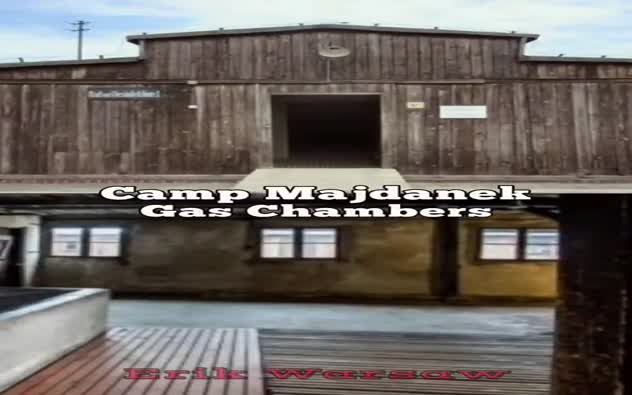







 Donate
Donate


